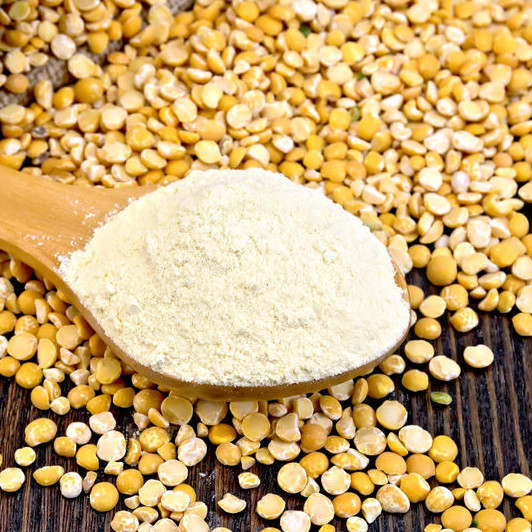Pea Protein
What is Pea Protein?
Pea protein is a plant based ingredient that allows a baker to increase the protein content of breads and other baked goods. It is extracted in concentrated or isolated form from fine milled yellow pea flour.
This creamy, white, water-soluble pulse powder has approximately 50% crude protein in the concentrate and 80% in the isolate.1 It is also loaded with the essential amino acid lysine which wheat is known for being low in. Pea protein is therefore complementary to wheat. Pea protein is:
- Economical
- Non-allergenic
- Non-GMO
- Gluten-free
- A good emulsifier
Origin
Peas are part of the legume family and considered a pulse. Pulses are crops harvested solely for the dry seed and do not include crops harvested green, such as green peas.2 Other pulses include chickpeas (garbanzo bean), lentils, lupins, kidney beans and faba beans. Pulses have been an essential part of the human diet for centuries.
Dried peas are in the genus Pisun and are believed to have originated in the Middle East or Mediterranean regions. Currently, countries in the Northern hemisphere, Canada, Russia and Ukraine, are the leading producers of dried peas.3 The value of pea production has grown from 49.48 million USD in 1990 to 524.35 million USD in 2013.3
Nutrition
Protein is evaluated for quality, including amino acid composition as well as the ability of the body to utilize it. The United States uses the PDCAAS (Protein Digestibility Corrected Amino Acid Score) to evaluate protein quality. Pulses, such as peas, are better sources of protein than cereals like wheat, barley and quinoa. Combining grains and pea proteins can increase PDCAAS.
Pulses are known to contain anti-nutrients which can limit the digestibility and nutrient absorption of proteins.5 Isolates, because of the way they are processed, have less anti-nutrients.
PDCAAS values of pea powders, wheat and combinations:4
| AAS | TDP% | PDCAAS | |
| Wheat Flour | 0.47 | 92.3 | 0.43 |
| Pea Flour (yellow) | 0.73 | 87.9 | 0.64 |
| Pea Concentrate (50% protein) | 0.58 | 92.6 | 0.54 |
| Pea Isolate (82% protein) | 0.54 | 97.1 | 0.53 |
| Pea/Wheat Flour (30:70) | 0.83 | 90.0 | 0.75 |
| Pea Isolate/Wheat Flour (10:90) | 0.65 | 92.3 | 0.60 |
| Pea Concentrate/Wheat Flour (10:90) | 0.61 | 90.2 | 0.55 |
AAS (Amino Acid Score): Amino acid with the lowest relative ratio relative to the established amino acid requirement values for humans age 2-5
TDP: (True Protein Digestibility)
PDCAAS (Protein Digestibility Corrected Amino Acid Scores) = AAS xTDP
Commercial Production
Protein concentrates and isolates come from pea flour which has undergone further processing to increase protein content. There are various methods of protein separation but they can be classified into two main categories:1
- Dry Separation: Utilizes the different densities of the pea flour components to separate the particles and increase protein content. For example, pea flour is passed through a spiral air stream in order to separate the coarse starch particles from the fine protein particles.
- Wet Separation: Utilizes the different solubilities of the protein to separate and increase protein content. For example, an alkaline extraction of the protein followed by protein precipitation allows for separation. Alkaline extraction has the added benefit of reducing anti-nutritive components.5
Peas are an exceptional source of protein, but can have a beany, earthy, bitter flavor that is oftentimes undesirable.1 Some manufacturers have developed processes to de-flavor pea proteins.
Application
Pea protein has emulsifier characteristics and can function as a vegan alternative for eggs in recipes. Additionally, pea protein will not lose structure functionality under high temperature.
Depending on the product, pea protein can perform similar, better or slightly less functional compared to eggs in cookies, cakes, muffins or waffles. Food scientists at North Dakota State University baked with pea concentrate and isolate and provided suggested recipes to the Northern Pulse Growers Association.6
FDA regulations
Some pea proteins have been recognized as GRAS by the FDA.7
References
- Nosworthy, M.G., Tulbeck, M.C., House, J.D. “Does the Concentration, Isolation, or Deflavoring of Pea, Lentil and Faba Bean Protein Alter Protein Quality?”. Cereal Foods World. 62:4, 2017, pp 139-142.
- FAO. Pulses and Derived Products draft. Definitions and Classification of Commodities, 1994, http://www.fao.org/es/faodef/fdef04e.htm#4.02, Accessed on 7 December 2018.
- FAO. Pulses: Nutritious Seeds for a Sustainable Future. 2016, pp 24, http://www.fao.org/3/a-i5528e.pdf, Accessed on 7 December 2018.
- Pulse Canada. Protein Quality of Cooked Pulses. http://www.pulsecanada.com/wp-content/uploads/2017/09/Pulses-and-Protein-Quality.pdf, Accessed 7 December 2018.
- Cassiday, L. Pulses Rising. American Oil Chemist Society. 2018. https://www.aocs.org/stay-informed/read-inform/featured-articles/pulses-rising-april-2018, Accessed on 7 December 2018.
- Northern Pulse Growers Association. Pea Protein. https://northernpulse.com/uploads/resources/658/pea-protein-brochure.pdf, Accessed 7 December 2018.
- U.S. Food and Drug Administration. “GRAS notices” accessdata.fda.gov. https://www.fda.gov/Food/IngredientsPackagingLabeling/GRAS/NoticeInventory/ucm495404.htm, Accessed on 7 December 2018.


